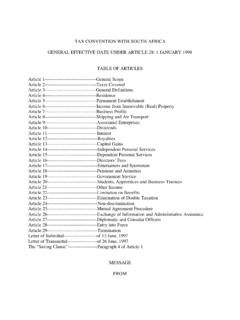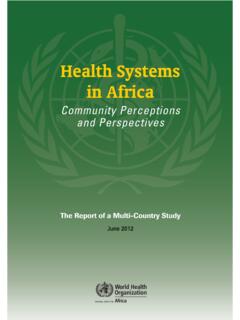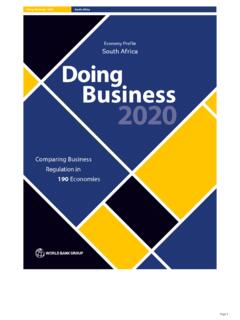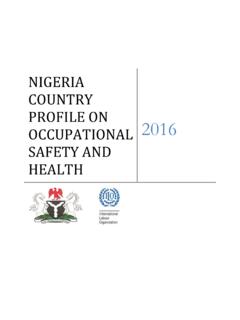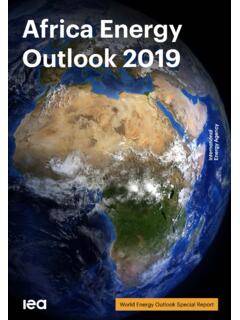Transcription of The impacts from a COVID-19 shock to South Africa’s ...
1 August / 2020 Rapid country Assessment: South africa The impacts from a COVID-19 shock to South africa s economy and labour market. Authors / Ilan Strauss, External consultant Gilad Isaacs, Co-Director of the IEJ Josh Rosenberg, Research assistant, IEJ Patieene Passoni, External consultant on input-output modelling Copyright International Labour Organization 2020 This is an open access work distributed under the Creative Commons Attribution IGO License (http://creativecom- ). Users can reuse, share, adapt and build upon the original work, even for commercial purposes, as detailed in the License. The ILO must be clearly credited as the owner of the original work. The use of the emblem of the ILO is not permitted in connection with users work. Translations In case of a translation of this work, the following disclaimer must be added along with the attribution: This translation was not created by the International Labour Office (ILO) and should not be considered an official ILO translation.
2 The ILO is not responsible for the content or accuracy of this translation. Adaptations In case of an adaptation of this work, the following disclaimer must be added along with the attribution: This is an adaptation of an original work by the International Labour Office (ILO). Responsibility for the views and opinions expressed in the adaptation rests solely with the author or authors of the adaptation and are not endorsed by the ILO. All queries on rights and licensing should be addressed to ILO Publications (Rights and Licensing), CH-1211 Geneva 22, Switzerland, or by email to ISBN: 978-92-2-0328828 (web PDF) The designations employed in ILO publications, which are in conformity with United Nations practice, and the presentation of material therein do not imply the expression of any opinion whatsoever on the part of the International Labour Office concerning the legal status of any country , area or territory or of its authorities, or concerning the delimitation of its frontiers.
3 The responsibility for opinions expressed in signed articles, studies and other contributions rests solely with their authors, and publication does not constitute an endorsement by the International Labour Office of the opinions expressed in them. Reference to names of firms and commercial products and processes does not imply their endorsement by the International Labour Office, and any failure to mention a particular firm, commercial product or process is not a sign of disapproval. The impacts from a COVID-19 shock to South africa s economy and labour market. 1 Preface The objective of the rapid country assessments launched by the Employment, Labour Markets and Youth Branch (EMPLAB) of the ILO around the world is to provide constituents and other stakeholders with a practical tool for the real-time diagnosis of the employment impacts of the COVID-19 pandemic to inform policy responses. The assessments examine the dramatic effects of the pandemic on economic growth and employment and how it has exacerbated labour market vulnerabilities and inequalities.
4 They also show the importance of a prompt and targeted policy response and the value of social dialogue. Given the large number of jobs lost in the wake of the 2008 global financial crisis (GFC), and the larger size of the COVID-19 crisis, via health and economic channels, we can expect at least as many job losses, if not more. South africa has been the hardest-hit African country ; globally, it has the 5th highest number of COVID-19 cases, despite some of the strictest lockdown regulations. Compounding this situation, the pandemic has come at a difficult time for South africa . Last year the economy was already slowing, leading to increasing unemployment. As a result, the COVID-19 crisis has led to a fall in formal employment and 9 out of 10 South African businesses have reported losses in turnover. This assessment investigates the short-term impact of the COVID-19 crisis on the South African economy and labour market, as well as exploring the effectiveness of measures related to the containment and reopening stages of the crisis.
5 The results present a somber picture on employment outcomes, revealing that groups, who were already disadvantaged before the crisis, have been disproportionately affected. The response to the COVID-19 pandemic needs a combination and sequencing of measures related to the containment, reopening and eventual recovery once the global pandemic has been brought under control. The four pillars of the ILO COVID-19 policy framework highlight the importance of maintaining stimulus, continuing support to enterprises, jobs and incomes, protecting workers in the workplace, especially for those at the frontline and using social dialogue to arrive at more effective policy solutions. Over the longer term, policymakers around the world need to address the persistent inequalities that have been exacerbated by the COVID-19 crisis and work towards building a better future of work and a more resilient labour market. Sukti Dasgupta Chief Employment, Labour Markets and Youth Branch The impacts from a COVID-19 shock to South africa s economy and labour market.
6 2 1. Overview As GDP collapsed over the first half of 2020, the COVID-19 crisis has evolved into the worse economic downturn since the Great Depression, severely impacting labour markets around the world, including in South The expected contraction of GDP in South africa will, according to the South African Reserve Bank (SARB), be worse than during the Great Depression in The OECD s June 2020 forecast is for unemployment rates to nearly double in OECD economies as a In a single-hit scenario, the OECD forecast is that South africa s narrow unemployment rate will increase from per cent in Q4 2019 to per cent by Q4 By limiting both consumers ability and confidence to spend and that of producers to provide goods and services, COVID-19 severely impairs the maintenance of production and employment levels. Governments have responded by attempting to sustain incomes, as consumption collapses, through transfer payments and increased unemployment benefits, and by maintaining employer employee working relations through furlough schemes.
7 In advanced economies with meaningful rescue packages, such schemes have attempted to be proportionate to the estimated incomes lost because of temporary and other job losses. Developing economies, although facing more limited fiscal space, are trying to raise external financing in an attempt to implement similar support measures. A higher number of informal sector workers, precarious workers and already unemployed workers means that such interventions are being designed differently in developing economies. The pandemic has come at a difficult time for South africa s highly unequal economy. South africa was already in recession prior to the arrival of COVID-19 , having experienced three quarters of continuous contractions to its GDP between Q3 2019 and Q1 South africa s level of unemployment is already among the highest in the world, at per cent as of Q1 2020. Large proportions of the working population earn below various measures of poverty.
8 Of those employed,6 per cent earn below the working poverty line of R5 086 ($300) per month, while 13 per cent earn below the Upper Bound Poverty Line (UBPL) of R1 183 ($70) per month; employment (including waged and self-employment) is a crucial means of tackling poverty. As a result, the virus risks exacerbating the already incredibly high levels of inequality and working poverty in South africa s labour market. In addition, a fall in tax revenue from a contracting economy, together with limited COVID-19 spending, is putting added strain on government finances, with regard to which the debt-to-GDP ratio is projected to increase rapidly, from per cent in early 2020 to per cent by year end,7 with a budget deficit of up to 16 per cent of GDP in 2020. This rapid assessment investigates the short-term impact of the COVID-19 crisis on the South African economy and the specific features of its labour market. It assesses the immediate impact of three possible contractions in final demand of 5 per cent, 10 per cent, and 15 per cent, on South africa s gross output, value-added, wages, and employment, focusing on the impact on employment by industry, gender, level of skill, formality, and wage earning level.
9 This in turn allows us to assess the extent to which current policies are able to stem or ameliorate the impacts of the pandemic on the South African labour market. As a short-run model, it assumes fixed prices and technology. As a result, we do not comment on the long-run impact of these shocks; for example, how long it will take the South African economy to regain the lost 1 See latest blog by IMF Chief Economist Gita Gopinath. Available at: 2 Lesetja Kganyago. Lecture. The coronavirus shock , and the age of magic money . Wits School of Governance Johannesburg 18 June 2020. The South African Reserve Bank. Available at: 3 OECD, 2020. Economic Outlook, June 2020. Available at: 4 Unless otherwise stated, the broad unemployment rate is used throughout the rest of the paper. 5 per cent in Q3 2019, per cent in Q4 2019 and 2 per cent in Q1 2020. In Q1 2019 the economy contracted by per cent. These are quarter-on-quarter contractions.
10 6 Persons in employment are defined as all those of working age who, during a short reference period, were engaged in any activity (even for only one hour) to produce goods or provide services for pay or profit. It thus includes wage or salaried work, own-account work, and self-employment, as well as informal employment across all sectors of the economy. 7 South African National Treasury, 2020. Supplementary Budget Review 2020. 8 This paper uses a short-run model and does not assess how the economy adjusts to the initial shock over time; in other words, how and what sort of equilibrium it returns to The impacts from a COVID-19 shock to South africa s economy and labour market. 3 South africa recorded its first COVID-19 case on 5 March 2020, just over three months after the outbreak was reported to the regional World Health Organization (WHO) office in Wuhan. At the time, Italy s death toll was nearing 80, with global cases rapidly approaching 100 000. On 15 March 2020, South African President Cyril Ramaphosa declared a National State of Disaster, with measures, including the closure of schools and travel restrictions, commencing just three days later.










